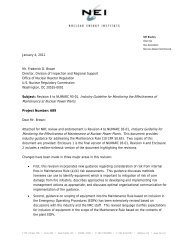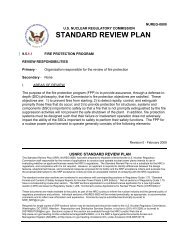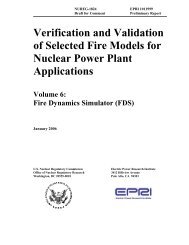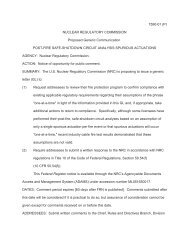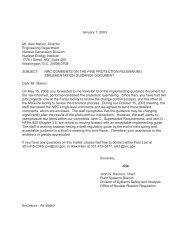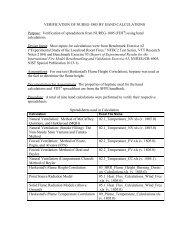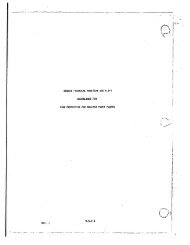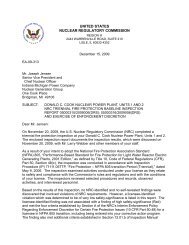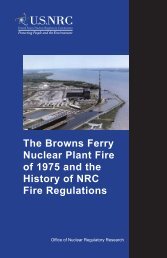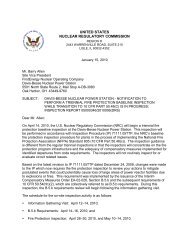NUREG/CR-6850, Volume 1 - NRC
NUREG/CR-6850, Volume 1 - NRC
NUREG/CR-6850, Volume 1 - NRC
You also want an ePaper? Increase the reach of your titles
YUMPU automatically turns print PDFs into web optimized ePapers that Google loves.
3.3 Limitations to the State-of-the-Art and their ImportanceConclusions and Closing RemarksThe Technical Development Teams reached a few technical areas where advancing thestate-of-the-art is either unattainable within current knowledge, and/or where the cost associatedwith obtaining the necessary knowledge is prohibitive. Note that the discussion here is notintended to exhaustively explore analysis limitations, but rather, to highlight specific limitationsrelevant to current topics of potential interest to users.3.3.1 Number of Combined Fire-Induced Spurious ActuationsIt is impractical to exhaustively explore all potential electrical cable failure modes in a fullydynamic context except for the most simplistic of component damage state scenarios. Hence,it is widely recognized that some optimization of the circuit analysis process is both necessaryand desirable. The recommended circuit analysis approach attempts to focus attention on thoseelectrical cables, cable failure modes, and circuit fault modes that may be risk-significant.The approach for the selection of components and cables recommends that analysts limitconsideration to combinations of two or three concurrent spurious operations in any one system.The analyst may, of course, consider more concurrent spurious operations, but as the numberincreases, the level of effort increases geometrically. The analyst will likely find that a point ofdiminishing returns is quickly reached (substantial effort necessary to add low likelihood failurecombinations). Once incorporated into the Fire PRA plant SSD response model, combinationsinvolving any number of spurious operations impacting multiple systems concurrentlycan be quantified. The proposed approach does not provide a systematic method to identifythe potential functional dependencies between the failed components of different systems.The NEI/EPRI/<strong>NRC</strong> [3.3, 3.4, 3.5] testing showed that the likelihood of occurrence of thecombinations decreases exponentially with the number of the postulated spurious actuations.It is the authors’ judgment that the recommended approach would capture dominant riskcontributors and offers substantial improvement over other alternative approaches availableto date for dealing with this issue.3.3.2 Estimating Spurious Actuation ProbabilitiesTask 10, Circuit Failure Mode Likelihood Analysis, provides methods for estimating thespurious operation probability for one or more components. These methods rely largely onpreviously available estimates of the conditional probability of spurious actuation given cablefailure. This project has not attempted to tabulate alternate spurious operation likelihood values 2 ;however, the consensus of the EPRI and RES Technical Development Teams is that additionalconsideration of the circuit failure mode likelihood values is warranted.2 An analytical equation has been suggested for “fine tuning” spurious actuation likelihood estimates to a specificcase, but this approach fundamentally relies on the same underlying data. It should also be noted that the equationbased method has received only limited peer review and application experience.3-7





